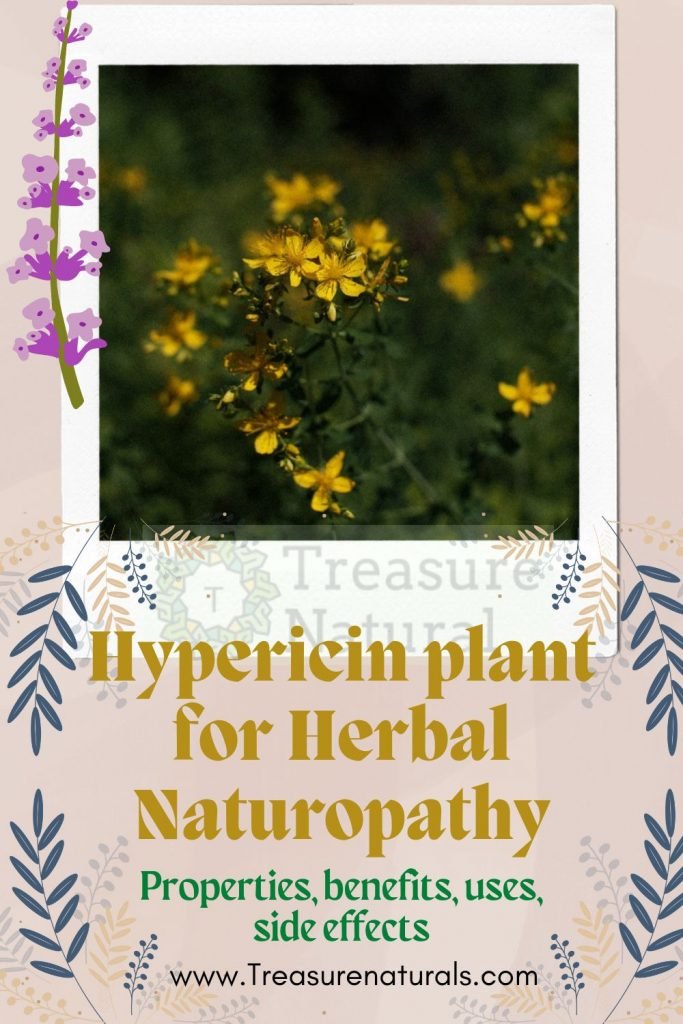
Hypericin is an active ingredient extracted from the Hypericum perforatum L. plant useful for regulating mood, the sleep-wake cycle, intestinal peristalsis and other metabolic activities. Let’s find out better.
What is Hypericin
Hypericin is a naphthodiandron extracted from the leaves and flowering tops of the Hypericum perforatum L. plant, and has been considered the main active ingredient as an antidepressant, subsequently supplanted by hyperforin.
The concentrations of these two molecules, both present in hypericum, obviously vary during the year and in the different parts of the plant. Traditionally, hypericum is harvested between 21 June, the summer solstice, and 24 June, the feast of St. John, hence the vulgar name with which the plant is known: ” St. John’s wort “.
Where is hypericin found
Hypericin is concentrated in the leaves and mainly in the flowering tops of the hypericum. Hypericum perforatum L. is a perennial herb up to 30-90 cm tall; cylindrical, smooth, erect stems, branched at the top; simple, oblong, whole, opposite, sessile leaves, up to 2,5 cm long, seen against the light show small pores, hence the specific name. The flowers have 5 (rarely 4) sepals and 5 (rarely 4) petals, and are gathered in terminal corymbs.
The plant blooms from June to August; it is present in all regions of Italy, preferring the edges of roads, meadows and clearings, it is found almost everywhere where the sun beats.
The hypericum phytocomplex includes, in addition to hypericin and hyperforin, flavonoids, quercetin, campferol, catechins, phloroglucins, volatile oils, xanthones, tannins, nicotinic acid, vitamins and more.
Properties of hypericin
Hypericin works by inhibiting the reuptake of brain amines (serotonin, noradrenaline) by binding to GABA receptors. Furthermore, it almost irreversibly inhibits both type A and B monoamine oxidase (MAO) in vitro; the inhibition of MAO type A, responsible for the inactivation of serotonin is the most extensive.
By limiting the reuptake and inactivation of serotonin in the central nervous system, hypericin favors a greater presence of the neurotransmitter in the circulation, ensuring better regulation of mood, sleep-wake cycle, intestinal peristalsis and others metabolic activities.
A hepatoprotective activity of the molecule, as well as antiviral, has also been demonstrated .
However, the antidepressant action remains the best known and studied also for its application implications that first made it a very powerful drug, then due to the multiple contraindications the governments of many countries, including France still today, have pushed for its ban, and now, with due precautions, the hypericum is regaining the place it deserves.
Hypericum is currently on the market as a mild and moderate antidepressant, also because the entire phytocomplex is well tolerated even in the elderly and shows an efficacy comparable to synthetic drugs.
Hypericum-based supplements are present in different pharmaceutical forms: hydroalcoholic extract or mother tincture, dry extract, herbal tea cut, oleolite, as well as in medicinal specialties. The average dose used daily to achieve antidepressant effects is 900 mg.
In recent years it has been observed that the antidepressant action attributable to hypericum is not found in standardized extracts of hypericin, precisely because this activity is more attributable to hyperforin and to the entire phytocomplex.
External use of hypericin
Hypericum perforatum L. oleolite is a powerful remedy also for external use. The main characteristic of the oleolito, or rather of the maceration in oil of the fresh plant, is the ruby red color. The coloration is due to hypericin.
For external use, hypericum oil is very effective as an anti- inflammatory, against sunburn, burns, skin redness due to inflammation or bruises, scars, wounds.
Contraindications of hypericin

Like any powerful drug, St. John’s wort is not without contraindications! Let’s see them in detail.
Hypericum shows interactions with numerous drugs, including: synthetic antidepressants, anticonvulsants, cyclosporine, digoxin, oral contraceptives, theophylline, warfarin, calcium channel blockers, antibiotics. Hypericum works by inducing the enzymes responsible for the metabolism of these drugs, represented in particular by the isoenzymes of cytochrome P450 in the liver.
These interactions can lead to a reduction in blood concentration and therefore in the effectiveness of the drugs themselves. On the other hand, the suspension of hypericum can lead to a disproportionate increase in the blood concentration of these drugs and therefore to toxicity.
In recent years the administration of hypericum extracts has increased and with it the reports of interactions with various drugs. So much so that some National Agencies have developed specific lists of drugs interacting with the plant extract.
Another contraindication on the use of hypericum for internal and external use is its photosensitivity. However, only a few cases have been documented in humans, which regressed following its suspension. Furthermore, other studies indicate that photosensitivity occurs only at very high doses of St. John’s wort, higher than those recommended.
Hypericum represents a classic example of how the belief in the harmlessness of the natural product can lead the patient, who undergoes complex therapies, not to inform the doctor, with serious consequences!






